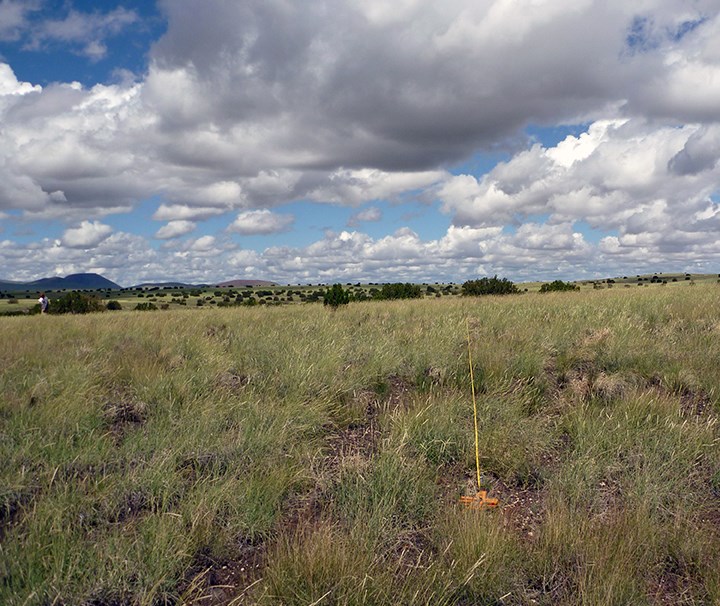Last updated: January 12, 2023
Article
Modeling Past and Future Soil Moisture in Southern Colorado Plateau National Parks and Monuments
In the semi-arid environment of the Colorado Plateau, soil moisture is an important driver of vegetation growth. The recent drought-related die-off of trees across the Southwest has highlighted how ecosystems may be vulnerable to changes in available water. Climate change models predict drier conditions over the next century.
How will these changes affect vegetation in these already dry ecosystems? The Southwest Biological Science Center of the U.S. Geological Survey (USGS) and the Southern Colorado Plateau Network of the National Park Service (NPS) have teamed up to answer this question. They used soil and vegetation data from ecosystems in nine network parks to model soil moisture under predicted climate conditions.
Their results predicted the drying of soils in spring would occur earlier in both the near term (2020-2059) and long term (2060-2099) future. This will shorten the time when soils are moist during the spring growing season. As a result, plant species that rely on soil moisture in the spring may be at higher risk due to drought. But this is only part of the story. The Colorado Plateau supports hundreds of species of plants, mammals, birds, reptiles and insects. How will wildlife respond to changes in their habitat? As we continue to collect data and improve modeling and other methods of analysis, we can learn more about the effects of climate change on arid ecosystems. With this knowledge, scientists can work on developing strategies that seek to improve long-term ecosystem resistance and resilience, thus, helping to preserve our parks for future generations.

NPS
Introduction
For this project, USGS and NPS scientists compared historical and predicted future climate data for nine Southern Colorado Plateau Network parks. They put this information into SoilWat2, a soil water model that takes information on soils and climate and translates it into an estimate of soil water availability. This estimate, or soil water potential (SWP), tells us how much water is available to plants for growth and survival.
Scientists determined SWP at 2 depths for each ecosystem: intermediate (20-50 cm) and deep (50-100 cm). They also looked at the amount of vegetation greenness, which represents plant growth, using satellite imagery over a 15-year period. For each grassland and shrubland ecosystem, they compared the SWP at both depths with the amount of greenness during a particular season. The depth at which SWP best correlated with plant growth represents the SWP that is most relevant to the dominant plants in each ecosystem. Results using this depth are presented in this report. For more details, please see the Methods section and the Natural Resource Report for each park ecosystem.
This article presents the following information for 13 ecosystems in nine national park units in the Southern Colorado Plateau Network of the National Park Service.
- results of modeled current and future SWP
- current and predicted future climate
- relationship of NDVI to soil water potential (grassland and shrubland ecosystems only)
Methods
1. Data were collected from the following sources for input into the SoilWat2 model:
- Texture and depth data from soil core samples that were taken during the establishment of SCPN upland monitoring plots (supplemented with soil texture data from soil surveys when the soil cores did not extend to the full depth of the soil profile).
- Vegetation species and functional group cover data from SCPN monitoring plots
- Daily weather data estimates (long-term historical weather) from 1920 to 2011 (Livneh et al. 2013)
- Projected daily weather for the periods 2020–2059 and 2060–2099. All projected climate data was downloaded from the Green Data Oasis.
2. SoilWat2 integrated these climate data, along with the soils and vegetation data, to generate the following simulations:
- long term historical daily soil water potential (1915-2010)
- near term historical daily soil water potential (1980-2015)
- near term future daily soil water potential (2020-2059)
- long term future daily soil water potential (2060-2099)
We used box plots to represent annual variation in each of the seasonal soil moisture projections for the respective time periods. For future time periods, we used the mean projected soil moisture. The SoilWat 2 model, along with the soil moisture simulations, is available at https://doi.org/10.5066/F7D50K6S.
3. Normalized difference vegetation index (NDVI) was generated bi-weekly from 2000-2014 using a neighborhood analysis of MODIS data. NDVI is an indicator of plant productivity and represents phenological timing in vegetation communities. NDVI ranges from 0 (low productivity) to 1 (high productivity). Recent work has found NDVI to be an unreliable tool in pinyon-juniper ecosystems (Norris and Walker, in review), so the NDVI-related analyses were not performed for the pinyon juniper ecosystems at GRCA, MEVE, or BAND.
4. We calculated annual NDVI by integrating the area under the NDVI curve as a representative measure of total annual productivity. Annual NDVI was then correlated with SWP averaged over windows ranging from 10 to 365 days throughout the year. This method of analysis allows us to look at the impact of timing and duration of water availability on annual NDVI.
Results
Present and future climate and soil moisture, and the relationship with NDVI for 13 ecosystems in nine SCPN national park units are presented here.
Tags
- aztec ruins national monument
- bandelier national monument
- chaco culture national historical park
- glen canyon national recreation area
- grand canyon national park
- mesa verde national park
- petrified forest national park
- petroglyph national monument
- wupatki national monument
- scpn
- swscience
- climate change
- climate change adaptation
- research
- project
- waterbalancecc
- jmrlc
- natural resources
